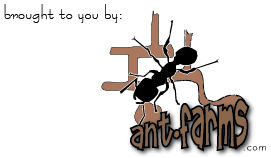The Eco System Ant Jungle

One of six products in the Wild Science Eco System series, and one of the four kinds of ant habitats, the Eco System Ant Jungle is a live ant habitat with a jungle feel to it. The green and brown colors of the container contribute to the jungle-like environment. Through the magnifying window of the Ant Jungle you can watch as the ants roam their habitat, carry their food, build their colony, and rush to the surface when their colony is in danger. As with the other Eco System products, this one can be connected with others with the help of the colony interlink tubes. The Eco System is designed to give one a real idea of these creatures’ environment and lives.
Ants make wonderful pets since they are so clean, easy to care for, and cost next to nothing to feed. It is fun and exciting to observe these ants in the Eco System Ant Jungle, at home, or in the classroom.
Contents of the Ant Farm
The Wild Science Eco System Ant Jungle kit includes an ant environment with a maze and a magnifying window, a pipette, tweezers, stickers, cotton balls, an ant catcher, an instructional booklet, and colony interlink tubes. The Ant Jungle does not include ants.
Ants
The ants are not included with the Ant Jungle kit. You can either order from an ant company separately or try and catch your own ants with the ant catcher provided with the kit. The downside about catching your own ants is that you cannot be sure what kind of ants they are and how they will adapt to the Ant Jungle environment. The ants that are normally sent to you are harvester ants. They are rather large and survive well in environments such as the Ant Jungle.
Make sure to follow the instructions while attempting to catch ants and always wear gloves. The ants can bite or sting. It is also important to never combine the ordered ants with ants that you have caught. They come from different colonies and will end up killing each other. That is why you should catch ants that are together. Then you know they are from the same colony.
Lifespan
Ants can survive a year or even longer in their natural habitat. However, without a queen ant, the ants will survive for only a few weeks. They may live longer and they may expire early. It depends on the condition in which they arrive to the Ant Jungle and how they are cared for.
Ant Care
Like most pets, the ants need to be fed and watered. However, overfeeding and overwatering them can kill them. It is important to follow the feeding and watering instructions carefully. Ants need little light. Direct light can kill them. The temperature should be kept at a comfortable 65 to 75 degrees Fahrenheit. The Ant Jungle should be kept on a sturdy surface. If it is shaken, the ants can be crushed.
Tips
It is best to put the ants in the refrigerator before introducing them to their new home. The cold temperature will slow them down, making the transfer into the Ant Jungle easier and smoother. If you choose to order the ants, make certain that someone is around to pick the ants up when they arrive so that they don’t sit too long in the mailbox.
Recommended Age
The Ant Jungle Eco System kit by Wild Science is recommended for age six and up. Children of all ages though will immensely enjoy this product, especially if it is connected with the other products from the Eco System series by Wild Science. It is fascinating to watch as the ants explore the different worlds, protect each other, and search for food.
Product Dimensions
1.7 Pounds


